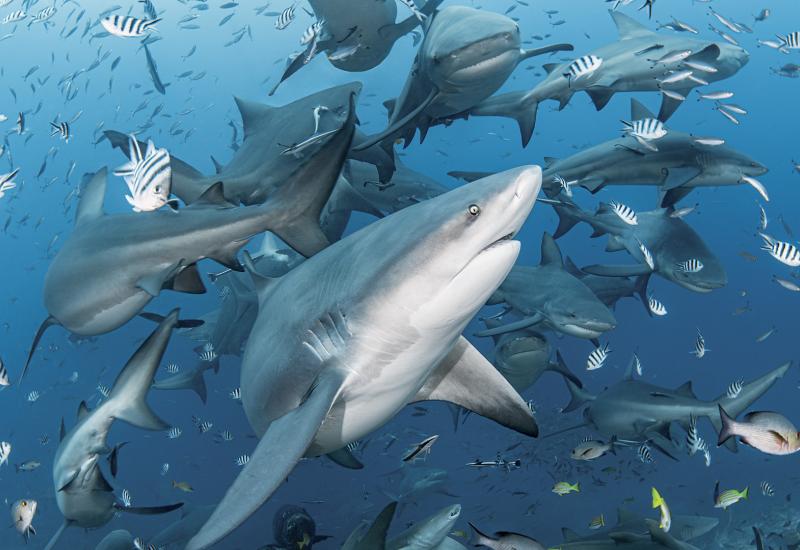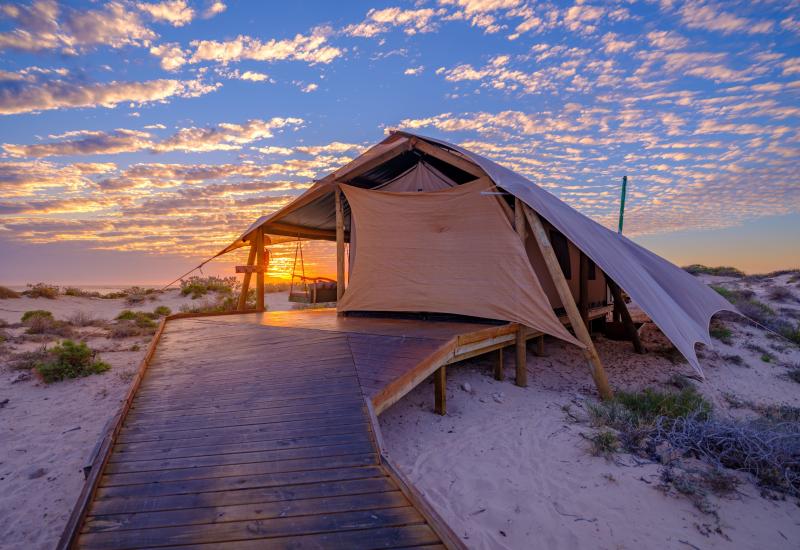Join the Pelagic Party in Byron Bay, Australia

Shutterstock.com/Rich CareyJulian Rocks is a delightfully sharky spot where you can see the stunning Indo-Pacific leopard sharks.
Byron Bay is a laid-back coastal town located on Australia’s most easterly point, about 110 miles south of Brisbane. It’s a travel hotspot known for surf beaches, music festivals and its lush hinterland, but we think it’s one of the world’s best-kept diving secrets.
When people think of diving in Australia, the Great Barrier Reef jumps straight to mind. Most divers—even Australians—tend to overlook a small outcropping of granite located 1.6 miles offshore from Byron Bay. Nguthungulli Julian Rocks (also called Julian Rocks or simply The Rock) is home to a pelagic party in the middle of the East Australian Current, where many migrating creatures stop by for a visit—humpback whales, manta rays, sand tiger sharks, Indo-Pacific leopard sharks (sometimes referred to as "zebra sharks" in the U.S.) and more.

Chris TaylorNguthungulli Julian Rocks is located just off-shore of one of Australia's most popular coastal towns.
It makes for exciting, dynamic diving suitable for divers of all levels—and thrills even the most seasoned pros.
Full disclosure: This is our local dive spot. Strangely, Julian Rocks is where we both did our first-ever dives, independently, nearly two decades before we met one another. It made an impression. We saw a turtle feasting on a jellyfish, a carpet of wobbegong sharks and encountered sand tiger sharks. Because of moments like these, Julian Rocks has our hearts, and it remains among our favorite places to dive. Such is the power of this place.
Magnet for Marine Life
The Julian Rocks Nguthungulli Nature Reserve is a 10,000-acre protected area banning all fishing within a 1,600-foot range around Julian Rocks. Surrounding the reserve is the Cape Byron Marine Park, which provides an extra layer of protection for the area’s rich biodiversity. The Rock’s long-term protection reveals itself in two ways: First, this place is teeming with marine life. Second, the life is accustomed to and unafraid of divers.
More than 1,000 species call The Rock home, including kingfish, snapper, barracuda, mulloway and scribbled pufferfish. You might see three species of sea turtle on one dive (green, hawksbill and loggerhead), eagle rays, large blotched fantail rays and three species of wobbegong sharks (Hale’s, ornate and spotted).
Related Reading: A Diver’s Guide to the World: Exploring Above and Beneath the Surface
Chris TaylorA pair of wobbegong sharks at Julian Rocks. It's not unheard of to see more than 50 of these Rock residents on a single dive.
Julian Rocks is a delightfully sharky spot, which is part of the reason we love diving here. From June to December, critically endangered sand tiger sharks (known here as gray nurse sharks) aggregate. From December through May, Julian Rocks hosts one of the largest known aggregations of Indo-Pacific leopard sharks, with more than 370 individuals recorded in 2023. You might also be lucky enough to spot the rare and endemic Colclough’s shark.
All the Action, Close to Home
Divers gear up at Sundive, the only dive shop in Byron Bay, and are transported a short distance to a local beach. The dive boat launches from shore and noses through a busy surf break. From there, it’s a 10-minute boat ride to The Rock.
Conditions determine how many dives are offered that day (one to three) and where the diving takes place. There are basically two directions you can travel around The Rock (as drift or return dives, depending on current and visibility). Underwater, the terrain is a shallow (max 80 feet) mix of rocky outcrops, trenches, swim-throughs and pinnacles, with sandy stretches in between.
Despite limited dive sites, Julian Rocks is worth multiple days of diving, due to ridiculous amounts of wildlife. You will never have a boring dive here.
Tip: Diving isn’t always easy, but this is a good place to push your skills a little, given the quality shop and focused dive area. This is also a great snorkel spot, with daily trips offered.
Chris TaylorFrom December through May, Julian Rocks hosts one of the largest known aggregations of leopard sharks.
From Rural Towns to Rainforests
With diving so close to shore, that leaves plenty of time to explore. You’ll spot the 1901-era Cape Byron Lighthouse from the dive boat—to reach this popular lookout, you can either drive to the top or take the 2.3-mile walking loop. Scan the surf for dolphins, turtles, rays and sharks. During the Southern Hemisphere winter (May to November), this is a great spot for whale-watching.
Spend time strolling through town. Browse The Book Room Collective, a vibrant, independent bookstore; pick up a gelato from Bella Rosa Gelateria & Espresso Bar; or enjoy a drink with ocean views at The Beach Hotel. Byron Bay has a well-deserved reputation for fantastic live local music—you won’t have to look far to find a venue with something on.
Take a short drive into the rolling green hills that surround the area, passing through quaint, picturesque towns like Newrybar and Clunes. There are also tracts of rainforest, threaded with walking tracks and waterfalls, like the 328-foot Minyon Falls, located in Nightcap National Park. This area is part of the Gondwana Rainforests of Australia World Heritage Area, the largest area of subtropical rainforest in the world. It is also a place of cultural significance, containing ceremonial and sacred sites that have been used by Indigenous Australians for thousands of years and are still being used by First Nations people today.

Chris TaylorThe 1901-era Cape Byron Lighthouse sits atop Australia's most easterly point and is a great lookout.
Need To Know
When to Go: Byron Bay is a year-round destination, with a huge amount of varied marine life that changes with the seasons. Southern Hemisphere summers are warm (79°F) with changing conditions, while winters (64°F) are usually mild and dry.
Dive Conditions: Conditions are very weather-dependent: You can have strong current, low viz or flat calm days with exceptional visibility. On average, visibility ranges between 16 to 82 feet. Water temperatures are around 61°F in winter and 79°F in summer. (We usually wear a 7 mm semidry in winter and a 3 mm in summer.) The site has a fixed depth of around 79 feet. Suitable for divers of all levels.
Related Reading: Peep Show: Dive with Hundreds of Thousands of Spawning Cuttlefish in South Australia
Operators: Sundive is currently the only dive shop in Byron Bay, so book your dives online well in advance. This is the original shop in the area. It’s a PADI Five Star Dive Center with a stellar reputation and knowledgeable guides and skippers. Courses are offered.
Travel Tips: If flying in/out of Brisbane, note that Brisbane is in a different state (Queensland) than Byron (New South Wales), and Queensland doesn’t observe Daylight Savings. That means in the Southern Hemisphere summer, there is a one-hour time difference between Byron and Brisbane. (This frequently catches visiting divers out!) Traffic can also get congested in this small, compact town, especially during summer or the holidays, so leave yourself plenty of time to get here and park.
Make a Difference: Your visit can help with critical citizen science research. The Cape Byron Leopard Shark Project relies on the local diving community to gather information on the habits and identities of these beautiful sharks, which are critically and globally endangered due to overfishing. How can you help? Take ID shots of any leopard sharks you see during your dive and share them with the team.

To create their one-of-a-kind National Geographic book, A Diver’s Guide to the World: Remarkable Dive Travel Destinations Above and Beneath the Surface, dive travel experts Carrie Miller and Chris Taylor traveled to 50 inspirational locations around the world, spending more than 250 hours underwater. Their monthly column explores the world using a mix of chapter excerpts and exclusive behind-the-scenes stories. Their project, Beneath the Surface Media, uses storytelling and ocean travel to encourage conservation through exploration. For more, follow them on Instagram and Facebook.










